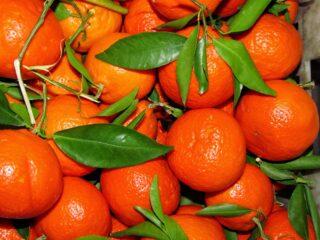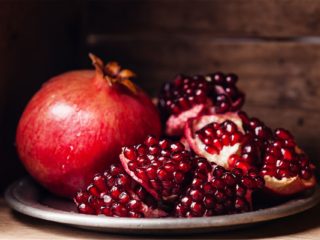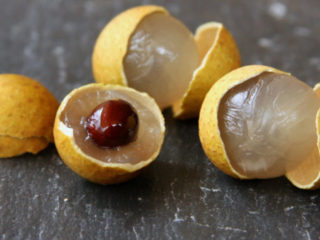Content
Any citrus fruit is very healthy, but at the same time it is a strong potential allergen. Therefore, nutritionists admit that tangerines can be given to children, however, certain norms and rules for their use must be observed, and “compatibility” with other products must be taken into account. Fruits are included in the diet gradually, carefully monitoring the condition and well-being of the child.
The benefits of tangerines for children
Everyone knows that tangerines are rich in ascorbic acid. But their benefits for the child are not limited to this. Citrus fruits contain a whole complex of vitamins (group B, D, A, K) and minerals (potassium, phosphorus, calcium, iron).

A significant advantage of fruits is that they do not contain nitrates harmful to a child’s health.
The benefits of tangerines for a child are very “multifaceted”:
- Essential oils in high concentrations provide the child with energy, maintain good mood and vigor, have a beneficial effect on memory and the ability to concentrate, stimulate brain function, and ensure healthy sleep.
- Citrus fruits are rich in pectin and fiber, which are necessary for the normal functioning of the child’s digestive system. They also stimulate appetite.
- The vitamin C contained is vital for maintaining immunity. It is an effective prevention of “seasonal” and other colds, a significant “help” for the child’s body during spring vitamin deficiency.
- Phytoncides contained in pulp and juice effectively destroy any pathogenic microflora, for example, helminths in the intestines. When applied externally, they are useful in the fight against fungal dermatological diseases in children.
- Tangerines contain calcium in fairly high concentrations, which is the main “building material” for the child’s musculoskeletal system.
- The orange color of the peel and pulp indicates the presence of lycopene and carotene in citrus fruits, which are necessary to maintain visual acuity, strengthen the cornea, and protect the mucous membranes from adverse “external” influences.
- Regular inclusion of tangerines in the diet activates metabolism. This means the rapid “processing” of food in the stomach and intestines, the absorption of nutrients into the blood and their “delivery” to organs and tissues. They also “help” the functioning of the excretory system, promoting the rapid removal of waste and toxins from the body.
- Citrus fruits prevent excess weight gain. They are low in calories (45-50 kcal per 100 g), despite the fairly high content of natural sugars.
- The white films and veins, as well as the peel of tangerines, are rich in natural flavonoids (in particular, nobiletin). For diseases of the bronchopulmonary system in a child, they help to thin and remove mucus from the lungs and fight dry cough.

Tangerines are very beneficial for the nervous system, “inhibiting” the synthesis of cortisol
At what age can tangerines be given to a child?
New foods are introduced into the diet only after consultation with a pediatrician. When it comes to tangerines, they recommend starting to introduce them to a one-year-old child (or a little earlier - at the age of 9-10 months). But only if he has not previously had an allergic reaction to food. Otherwise, you will have to wait up to 2-2.5 years.
Rules and regulations for the consumption of tangerines for a child per year
Speaking about tangerines, we must not forget: regardless of how many months they can be given to the baby according to the pediatrician, they begin “complementary feeding” very carefully, literally with a teaspoon of juice half diluted with water. If there is no negative reaction, offer a small slice, cleared of film and seeds.
When one of the immediate family is allergic to citrus fruits or the child himself has already had a negative reaction to other foods, tangerines are included in the diet, following certain rules:
- Offer juice or pulp in the morning so that you can constantly monitor the child’s condition throughout the day. An allergy to tangerines is indicated by red or rashy cheeks, swollen lips or tongue.
- On this day, exclude other new foods from your diet so that there is no doubt about the cause of the allergy.
- Postpone “acquaintance” until late autumn or winter: then it is easier to buy ripe, fresh and juicy tangerines.

It is better to give citrus fruits as a snack, after the main meal, to avoid digestive problems in the child.
How often to give
In autumn or winter, when tangerines have the most health benefits, and the child is especially prone to colds and viral diseases, they can be included in the diet 4-5 times a week. Daily consumption is still not recommended, so as not to “overfeed”: any food that has become boring will inevitably cause him to be rejected.
Quantity
Starting with 1-2 cloves, after 1.5-2 months the “portion” is increased to a whole small tangerine. In total, pediatricians recommend limiting preschoolers to 2-5 citrus fruits per day, depending on their size.

The “daily norm” for the consumption of tangerines is determined individually, depending on how much the child likes citrus fruits
What can be combined with
Despite their pronounced sweetness, nutritionists still classify tangerines as sour fruits. Therefore, they are recommended to be combined with fruits and berries from the same category:
- oranges, grapefruits;
- pineapples;
- grapes;
- currants;
- cranberries;
- apples.
Tangerines also go well with dairy and fermented milk products - yogurt, sour cream, cottage cheese, cream. You can try “combining” them with cream and regular cheese and herbs and nuts.

Yogurt with tangerines is a very light and healthy dessert for a child.
Harm of tangerines for a child
In addition to the fact that citrus fruits often provoke allergies, they can be hazardous to health for other reasons:
- Vitamin C in high concentration increases the acidity of gastric juice, which, in turn, irritates the mucous membranes, leading to heartburn.
- If a child suffers from liver and kidney diseases, tangerines can provoke a deterioration in health by “blocking” the work of certain enzymes.
- Freshly squeezed undiluted tangerine juice, if abused, destroys tooth enamel and negatively affects the condition of the oral mucosa.

To avoid problems with the oral cavity, it is better to drink tangerine juice through a straw.
What to do if your child has allergies
An allergy to citrus fruits and, in particular, tangerines is a fairly typical phenomenon for a child. Most often it appears at the age of 2-3 years, after 3-4 years it can disappear “spontaneously”. Symptoms range from minor rashes, redness and burning of the skin to severe itching of the mucous membranes, uncontrollable lacrimation, noticeable flushing, swelling, abdominal cramps, bouts of diarrhea and nausea, persistent migraines, dizziness and breathing problems.
Citrus fruits, despite all their benefits, will have to be excluded from the diet. This is much better for the child than constantly taking antihistamines or corticosteroids (local or systemic).It is also necessary to avoid any drinks that contain tangerine juice and essential oils that can cause irritation of the mucous membranes when inhaled.
Symptoms that have already appeared require contacting a pediatrician. He prescribes medications to the child depending on how exactly and how intense the allergy manifests itself. As a rule, treatment includes sorbents that help remove the “remnants” of the allergen from the child’s body as quickly as possible.
How to choose and store tangerines correctly
The best choice for a child is sweet tangerines with a very slight sourness. The ripeness and juiciness of citrus can be determined by several signs:
- light but clearly distinguishable citrus scent;
- bright orange skin of the same color, without spots;
- the average size;
- juice released when pressed with a fingernail on the skin.
Tangerines that meet any of the criteria are definitely not suitable for a child:
- excessive density when pressed, unnaturally large weight for this size;
- any mechanical damage to the skin, even minor, traces of mold, rot, and other fungal diseases;
- dents remaining on the skin after pressing with a finger;
- wrinkled, “woody” peel, which is very difficult to peel off the tangerine;
- strong “flattening” or very large size (such fruits are most often sour, the child will not eat them);
- unnatural lightness.
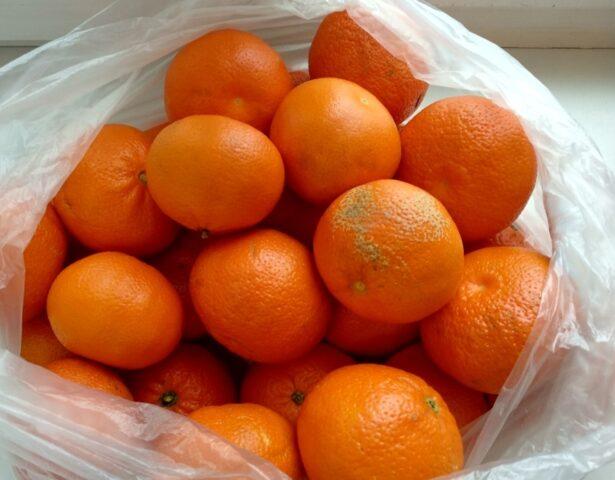
Without air access, tangerines quickly begin to rot.
At room temperature, tangerines can be stored for 5-7 days. Then they begin to deteriorate and should not be given to your child. You can extend the “shelf life” to 2-4 weeks if:
- wrap each citrus with parchment paper or foil and place in a large saucepan, tightly closing it with a lid;
- rub the peel with vegetable oil;
- put the tangerines in the refrigerator, in the compartment for storing vegetables and fruits;
- place in cardboard boxes or wooden boxes and leave on an insulated balcony, loggia, or cellar.
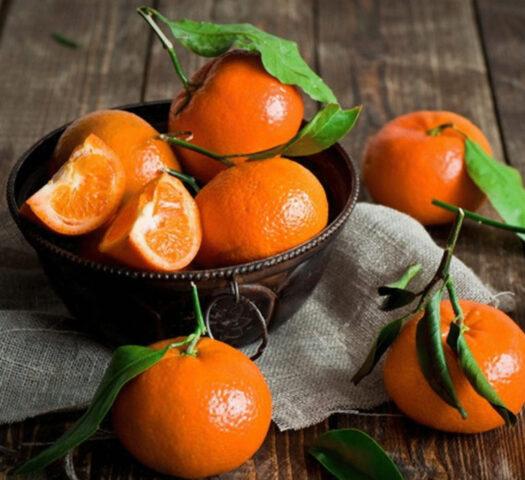
Citrus fruits with branches last longer
Conclusion
The benefits of citrus fruits are recognized by official medicine, so tangerines can and should be given to children, but only from a certain age, in the absence of individual intolerance and other contraindications. However, it must be remembered that if overused, tangerines can be harmful to health. The same goes for spoiled citrus fruits if you choose them incorrectly when purchasing and store them.


